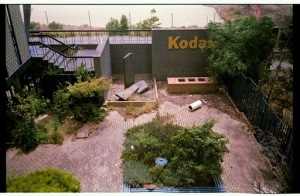Rachel Whiteread, Ghost (1990)
Monthly Archives: August 2012
Situation and Time: Tacita Dean
Tacita Dean’s work plays with themes of history, situation, and time. She works primarily with 16mm film, and her videos feature primarily minimalist landscapes, and other artists also interested in the thematic of time like Cy Twombly.
She has an amazing way of capturing the exact moment when a place or an object transitions into obscurity or into the unknown—for example, her work Kodak (2006) consists of a video made at the Kodak factory in Chalon-sur-Saône, shortly before it closed.
The transition in Kodak is double. The first is that the factory in itself is transitioning from being into non-being: a once-functional organism is forced to shut down for purely economic reasons. The second, related transition of Kodak, is the transition from film to digital media. Kodak was once produced over 90% of all film sold in the United States. With the rise of digital cameras, and the simplicity of editing photographs through programs such as Photoshop, film has become all but obsolete. As a result, the factories have been abandoned, left to decay.
Situations or locations becoming or being void have a particular meaning for Dean. In her article ‘Tristan de Cunha’ she talks about an island that is considered to be one of the most remote places in the world—the only means of reaching the island is by a boat, which travels there one a year. “So I realized suddenly, what it is at the heart of this draw to the Earth’s edges – to the desert and to the sea, or to the ice at the bottom of the world, or the volcano risen out of the ocean. In these places, we are not bound by the rules of time; we can be free of a history that cannot mark a surface in constant flux like that of the sea or the shifting dunes of the desert, or one brutalized by weather or extremity. In these places, we can imagine milennia; we can imagine prehistory and can see the future.”—Tacita Dean, ‘Tristan de Cunha’, Artforum, vol.43, no. 10 (Summer 2005) 275.
Only when time abandons a particular situation are we able to construct what it might have been, playing out an imagined history of events.


